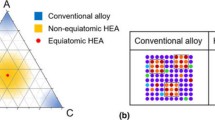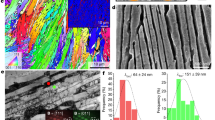Abstract
One of the most used additive manufacturing (AM) techniques is fused filament fabrication (FFF), which is primarily used for processing polymers. An interesting strategy to utilize this technique in metal processing is to adapt semisolid processing principles. Herein, low-melting Sn–Bi alloys were investigated to identify the ideal composition and processing conditions for semisolid AM using FFF. For this purpose, thermodynamic simulations were used to characterize the evolution of liquid fractions with temperature, and the results led to the selection of Sn-38Bi alloy (mass/%) for experimental validation. This composition was prepared by casting in an inert environment, followed by thermal analysis. The differential scanning calorimetry results were reasonably consistent with the simulated results. The as-cast Sn-38Bi was extruded to produce a metallic filament. To investigate the microstructural evolution in the semisolid state, samples from the filament were subjected to multiple heat treatments at different temperatures. Semisolid AM for the selected alloy was successfully performed at 170 °C. This process included extrusion and deposition without nozzle clogging or discontinuity formation. Various geometries were successfully fabricated, and the results demonstrated the efficacy of the FFF technique for processing metallic materials.
Graphical abstract







Similar content being viewed by others
References
SS Crump. Apparatus and method for creating three-dimensional objects. United States of America; 1992. p. 15.
Mohamed OA, Masood SH, Bhowmik JL. Optimization of fused deposition modeling process parameters: a review of current research and future prospects. Adv Manuf. 2015;3:42–53.
Murr LE, Martinez E, Amato KN, Gaytan SM, Hernandez J, Ramirez DA, et al. Fabrication of metal and alloy components by additive manufacturing: examples of 3d materials science. J Mater Res Technol. 2012;1:42–54.
Guo N, Leu MC. Additive manufacturing: technology, applications and research needs. Front Mech Eng. 2013;8:215–43.
Joly PA, Mehrabian R. The rheology of a partially solid alloy. J Mater Sci. 1976;11:1393–418.
Flemings MC. Behavior of metal alloys in the semisolid state. Metall Trans A. 1991;22:957–81.
Barnes HA. Thixotropy a review. J Non-Newtonian Fluid Mech. 1997;70:1–33.
Rice CS, Mendez PF, Brown SB. Metal solid freeform fabrication using semi-solid slurries. JOM. 2000;52:31–3.
Finke S, Feenstra FK. Solid freeform fabrication by extrusion and deposition of semi-solid alloys. J Mater Sci. 2002;7:3101–6.
Chen W, Thornley L, Coe HG, Tonneslan SJ, Vericella JJ, Zhu C, et al. Direct metal writing: controlling the rheology through microstructure. Appl Phys Lett. 2017;110:094104.
Jabbari A, Abrinia K. A metal additive manufacturing method: semi-solid metal extrusion and deposition. Int J Adv Manuf Technol. 2017;94:3819–28.
Jabbari A, Abrinia K. Developing thixo-extrusion process for additive manufacturing of metals in semi-solid state. J Manuf Process. 2018;35:664–71.
Lima DD, Campo KN, Button ST, Caram R. 3D thixo-printing: a novel approach for additive manufacturing of biodegradable Mg-Zn alloys. Mater Des. 2020;196: 109161.
Englert L, Klumpp A, Ausländer A, Schulze V, Dietrich S. Semi-solid wire-feed additive manufacturing of AlSi7Mg by direct induction heating. Addit Manuf Lett. 2022;3:100067.
Chang Z, Wang X, Wu Y, Peng L, Ding W. Review on criteria for assessing the processability of semisolid alloys. Mater Lett. 2021;282:128835.
Liu D, Atkinson HV, Jones H. Thermodynamic prediction of thixoformability in alloys based on the Al–Si–Cu and Al–Si–Cu–Mg systems. Acta Mater. 2005;53:3807–19.
Maciel Camacho A, Atkinson HV, Kapranos P, Argent BB. Thermodynamic predictions of wrought alloy compositions amenable to semi-solid processing. Acta Mater. 2003;51:2319–30.
Han Q, Viswanathan S. The use of thermodynamic simulation for the selection of hypoeutectic aluminum-silicon alloys for semi-solid metal processing. Mater Sci Eng A. 2004;364:48–54.
Li YD, Apelian D, Xing B, Ma Y, Hao Y. Commercial AM60 alloy for semisolid processing: alloy optimization and thermodynamic analysis. Trans Nonferrous Met Soc China. 2010;20:1572–8.
Liu YQ, Das A, Fan Z. Thermodynamic predictions of Mg-Al-M (M = Zn, Mn, Si) alloy compositions amenable to semisolid metal processing. Mater Sci Technol. 2004;20:35–41.
Campo KN, de Lima DD, Lopes ÉSN, Caram R. On the selection of Ti–Cu alloys for thixoforming processes: phase diagram and microstructural evaluation. J Mater Sci. 2015;50:8007–17.
Kattner UR, Boettinger WJ. On the Sn–Bi–Ag ternary phase diagram. J Electron Mater. 1994;23:603–10.
Zhang Q, Li H, Han B, Huang K, Fang X, Chen Z. A distinctive Pb-Sn semi-solid additive manufacturing using wire feeding and extrusion. J Manuf Process. 2022;80:247–58.
Gülseren MK, Kovan V, Tezel T. Three-dimensional printability of bismuth alloys with low melting temperatures. J Manuf Process. 2023;92:238–46.
Zoqui EJ, Benati DM, Proni CTW, Torres LV. Thermodynamic evaluation of the thixoformability of Al-Si alloys. Calphad. 2016;52:98–109.
Mireles J, Espalin D, Roberson D, Zinniel B, Medina F, Wicker R. Fused deposition modeling of metals. In Proceedings solid free fabrication symposium 2012;6–8.
Brabazon D, Browne DJ, Carr AJ. Mechanical stir casting of aluminium alloys from the mushy state: process, microstructure and mechanical properties. Mater Sci Eng A. 2002;326:370–81.
Lashkari O, Ghomashchi R. The implication of rheology in semi-solid metal processes: an overview. J Mater Process Technol. 2007;182:229–40.
Lashkari O, Ghomashchi R. The implication of rheological principles for characterization of semi-solid Al–Si cast billets. J Mater Sci. 2006;41:5958–65.
Campo KN, Lopes ESN, Parrish CJ, Caram R. Rapid quenching of semisolid Ti–Cu alloys: insights into globular microstructure formation and coarsening. Acta Mater. 2017;139:86–95.
Hitchcock M, Wang Y, Fan Z. Secondary solidification behaviour of the Al–Si–Mg alloy prepared by the rheo-diecasting process. Acta Mater. 2007;55:1589–98.
Annavarapu S, Doherty RD. Inhibited coarsening of solid-liquid microstructures in spray casting at high volume fractions of solid. Acta Metall Mater. 1995;43:3207–30.
Fan L, Zhou M, Zhang Y, Tang Q, Quan G, Liu B. The semi-solid microstructural evolution and coarsening kinetics of AZ80-0.2Y-0.15Ca magnesium alloy. Mater Charact. 2019;154:116–26.
Fu J, Wang S, Wang K. Influencing factors of the coarsening behaviors for 7075 aluminum alloy in the semi-solid state. J Mater Sci. 2018;53:9790–805.
Kim HS, Stone IC, Cantor B. Microstructural evolution in semi-solid AA7034. J Mater Sci. 2008;43:1292–304.
Acknowledgements
The authors gratefully acknowledge the financial support from CNPq (National Council for Scientific and Technological Development), Grant 405054/2016-5, and Fapesp (São Paulo State Research Foundation), Grant 2018/18293-8.
Author information
Authors and Affiliations
Contributions
DDdeL: Conceptualization, Investigating, Formal Analysis, Writing—Review & Editing. KNC: Conceptualization, Formal analysis, Writing—Original Draft. RC: Writing—Original Draft, Supervision, Funding acquisition.
Corresponding author
Ethics declarations
Conflict of interest
The authors declare that they have no conflict of interest.
Additional information
Publisher's Note
Springer Nature remains neutral with regard to jurisdictional claims in published maps and institutional affiliations.
Rights and permissions
Springer Nature or its licensor (e.g. a society or other partner) holds exclusive rights to this article under a publishing agreement with the author(s) or other rightsholder(s); author self-archiving of the accepted manuscript version of this article is solely governed by the terms of such publishing agreement and applicable law.
About this article
Cite this article
de Lima, D.D., Campo, K.N. & Caram, R. Coupling thermodynamic simulation and thermal analysis to select Sn–Bi alloys for semisolid additive manufacturing. J Therm Anal Calorim 148, 9423–9433 (2023). https://doi.org/10.1007/s10973-023-12337-4
Received:
Accepted:
Published:
Issue Date:
DOI: https://doi.org/10.1007/s10973-023-12337-4




